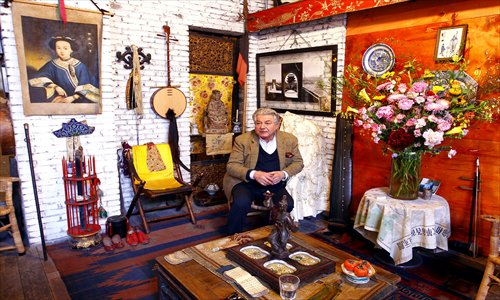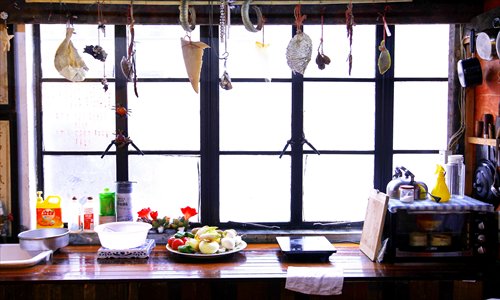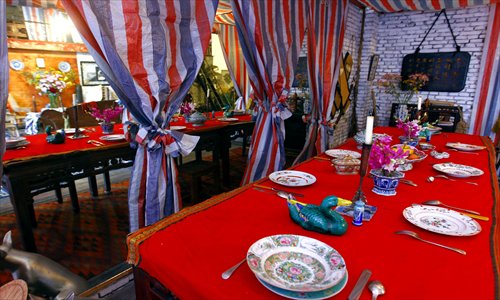Home is where the heart is

The home of French artist Christian de Laubadère,which is decorated with objects he collected over the years. Photos: Yang Hui/GT
Inside antiquated carved wooden frames is a Chinese woman bowing her head to work on an embroidery. Behind her, reflected in a mirror, hangs a ham, a pickled sausage, a bundle of shriveled tobacco and a dried gourd. The woman is surrounded by stainless steel pots and pans and also blue and white Chinese porcelain dishes, bowls and vessels. A light bulb emits a warm yellow glow from above, pouring light on the woman and the objects, through the reflection of the mirror.
"It's very warm, isn't it?" French artist Christian de Laubadère, whose Chinese name is Lu Mi, beamed as he introduced a view of his kitchen in Shanghai to the Global Times. The Chinese woman is de Laubadère's girlfriend, who has been with the French artist since he moved to Shanghai more than 10 years ago.
"I like the kitchen very much, which I think is the symbol of a family," de Laubadère said. "The only thing I always kept from my hometown in France here in Shanghai is a cookbook about French cuisine."
Several years ago, in order to create a huge painting for a hotel in Lhasa, de Laubadère had to move out of his small residence and studio on Huashan Road. He rented a deserted factory warehouse hidden on the ground floor of a commercial building in Changning district and converted it into a house, painting the exposed brick wall white and filling the 220-square-meter space with odds and ends he has collected over the years.
"This is our third residence in Shanghai, and the largest one," de Laubadère's girlfriend told the Global Times. "He was so excited after finding this space since it finally gave him an opportunity to display all of his Chinese porcelain, antiques and handicrafts which he bought from the antique and flea markets on Fangbang Road and Henan Road in Shanghai, and also other places he's traveled to, like Tibet, Taiwan and India."
Entering through a thick cloth curtain door, the space is divided into a living area at the front and the painting studio in the back. The living area consists of a reception space, a kitchen and a bedroom above built by iron and wood beams. Through an iron staircase, the bedroom connects itself with the space below to form a loft.

The home of French artist Christian de Laubadère,which is decorated with objects he collected over the years. Photos: Yang Hui/GT
In the reception space, the red, white and blue-striped plastic fabric which is ubiquitous in China and also inspired Louis Vuitton to make into a handbag in 2007, has been erected in a tent in order to create a dining area. Four Chinese Eight Immortals tables placed together on a colorful rug form a long dinner table draped in a dark red tablecloth.
Hanging on the wall is a yellow-tinged portrait of a Qing-era Manchu woman, which de Laubadère said is the inspiration for his famous series of Neck paintings, completed and unfinished examples of which are in his studio.
They all depict the back of women's heads, their hair arranged into intricate, traditional Chinese hairstyles, jewelry in their coiffures or fastened at their ears and rich fabrics draped at their shoulders.
"When I was looking at portraits of Manchu women, I noticed that their hairstyles are very uniform as the color and texture rarely differ from person to person," de Laubadère said.
A Chinese pipa is hanging beside the portrait, with a rusty lance against the corner of the wall. Next to a large vase of fresh flowers are more Chinese instruments, a guqin and an erhu.

The home of French artist Christian de Laubadère,which is decorated with objects he collected over the years. Photos: Yang Hui/GT
"I'm finding teachers to teach me to play them," de Laubadère said. Sitting in a rattan chair, he picked up several embroidered purses on a wooden tea table, whose colors have faded with age.
"But don't you think the faded colors just made them more beautiful? Together with the embroidered patterns, they form an abstract painting," de Laubadère said.
His girlfriend told us that ever since de Laubadère first came to Shanghai, he began to peruse the antique and flea markets on Fangbang Road and Henan Road. When vendors peddle their various wares, de Laubadère almost always accepts them without questions.
"I did feel a little helpless at first, but later, when I found that he cherishes everything he buys, no matter if it's fake or real, cheap or expensive, looks beautiful or ugly, I knew I had to get used to it," she said.
"Those old things always remind me of the time when I was in my hometown, which I still find touching," de Laubadère said.
On a table near the door of the space is a photo frame with a portrait of a 74-year-old Li Hongzhang, a politician, general and diplomat of the late Qing Dynasty (1644-1911).
"It was a present that Li gave to an ancestor of my family when he was visiting France in 1896, and then, when I came to China, I brought it back."
De Laubadère's studio in Shanghai can be visited by appointment. To arrange a viewing, contract Anne Cecile Noique by emailing acn@anne cecilenoique-art.com.